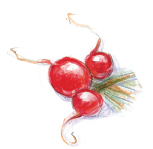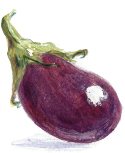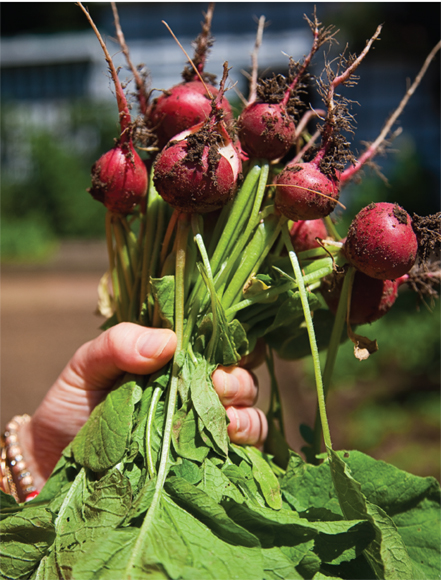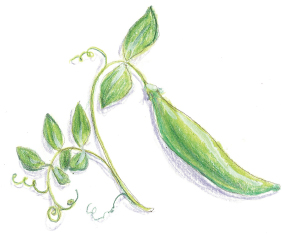
Not all of you are ready to take the big leap and drop all animal products from your diet cold turkey, the way I did. Some of you might want to ease into giving cruelty-free eating a try. Others might realize that you and your family are not eating enough vegetables and know the change would be good for everyone. You are not alone. Only a quarter of Americans eat at least three servings of vegetables a day—and that includes potatoes. Since the current guidelines recommend a minimum of four daily servings of vegetables for women and five for men and two to four servings of fruit, we are far off the mark in our eating habits. Most of us Americans need to add more vegetables and fruits to our diet.

I would like to change the way you think about food. Instead of always building a menu around meat, poultry, fish, and eggs, you’ll see how easy it is to make satisfying, yummy dishes from vegetables, grains, legumes, and fruits. My intention is to take the crunch out of granola and to inspire you to try a different way of cooking.

All the interest in farmers’ markets and eating locally grown food has become a trend. “Locavores” are taking the next step and are becoming “vegavores,” who love vegetables. Chefs all over the country are rising to the challenge and experimenting with vegetarian cuisine. “Meatless Mondays” have become popular in the best restaurants. I hope my delicious and flavor-packed recipes in Simple Pleasures will inspire you to eat more wholesome, fresh food. You can make small adjustments to eat well and to take advantage of the fresh produce that is available each season. That is why I have done this book by seasons—to make it simple.
Radishes straight from the dirt. I love to wash them off in the garden and eat them ASAP when they are still warm from the ground.

There is so much to say about wholesome eating that it’s impossible for me to cover all the issues and recommendations in a single chapter. Instead, I am giving you a quick look at what mattered to me as I became more focused on what to eat. Since I am not a doctor or a health professional, I have asked my friends, experts in their fields, to cover subjects that I think are important. They help me keep my body, mind, and spirit in the best shape possible. I want to pass on the advice they have given me in their own words. Their insights and knowledge are always a huge help and inspiration to me.
After my mother died, I gained thirty-five pounds. I went on a strict regimen and lost the weight, but my body still wasn’t right. My emotions were overwhelming. My body had stopped. I went to a doctor who gave me some supplements that made me so sick I couldn’t get out of bed. I had always been so active, and now I couldn’t walk around the block. I felt my body had short-circuited. I was a mess—and terrified!
My friend Suzanne Somers recommended Dr. Michael Galitzer, who practices energy medicine and homeopathy. He saved my life. He taught me how the mind affects the body and how the organs work. I asked him to help me fill you in on some of the most important nutritional and environmental issues that affect your well-being. Now that you are thinking about eating in the most healthful way, I asked him to give you guidelines about the foods you should steer clear of.
1. Red meat Meat contains hormones and antibiotics that impair health. If you remain a carnivore, try to stick to grass-fed and hormone-free meat. The same goes for chicken and other poultry.
2. Pork and processed meats
Pork has been associated with viruses, and the additives in processed meat can be harmful.
3. Peanuts contain a mold called aflatoxin that has been associated with cancer. Many people are allergic to them.
4. Dairy Many people are sensitive to cow’s milk or have a casein allergy. Casein, a protein in milk, can produce a reaction that includes a runny nose, itchy skin, or swollen lips.
5. Sugar and artificial sweeteners Sugar weakens the immune system. Artificial
sweeteners have been associated with weight gain and can be harmful to brain cells.
6. Alcohol is a toxin and a depressant.
7. Trans-fatty acids, vegetable oils, and fried foods are associated with increased risk of cardiovascular disease.
8. Carbonated soft drinks are very acidic, and non-diet soft drinks have ten tablespoons of sugar in twelve ounces.
9. Tuna and swordfish have a high mercury content. Mercury is harmful to the hormonal and immune systems.
10. Allergic foods Eight foods are responsible for 90 percent of food allergy reactions: milk, eggs, peanuts, tree nuts (cashews, walnuts, and almonds), corn, shellfish, soy, and wheat. Eating these foods can cause immune reactions that have to be neutralized by the liver and the adrenal hormones, which can contribute to adrenal fatigue.
MICHAEL GALITZER, M.D.
L ast year as my birthday present I asked my friends to give me one meatless day a week, or if that was too much, once a month. Most are still doing it, and are surprised at how they are making different choices with their food across the board. We become accustomed to what we eat. My friends are finding that eating differently has changed their taste buds. Junk food and meat have lost their appeal. They have found that reducing their weekly intake of animal products one thing at a time works. You might stop eating bacon, butter, or burgers for a week and then drop eggs, cheese, or ham. Eventually, you will not be eating any animals at all! You won’t even miss those foods, because you will feel so good.
When you eat this way, your experience will be like mine. You won’t feel deprived. You will find your cravings for animal protein slipping away, because the recipes in this book are so yummy and delectable. You will connect to the earth’s energy. Eating this way will make you feel so much lighter, with so much energy—and we all love energy! You will want to tell everyone, so they can feel the same way you do. The recipes in Simple Pleasures have health benefits, and the best part is that no animals will suffer.
I am now intuitive about what I eat. I listen to my body and have developed a sense of what it needs to function at its best. I have become sensitive to how I react to foods—what makes my eyes puffy, what brings me down, what makes me feel bloated, heavy, and tired, or on the positive side, what gives me energy, makes my skin glow, and keeps me light and happy.
For me, meat substitutes do not work. I don’t enjoy food that pretends to be something else. I really don’t want to eat bacon, hot dogs, sausage, or meatballs. I would rather eat fresh vegetables, grains, beans, and nuts. For many people who are making the transition to a cruelty-free diet, eating tempeh, seitan, and tofu satisfies the taste for animal products. I have included recipes that use these foods—like shepherd’s pie made with seitan, or spinach-tofu lasagna, because so many vegetarians and vegans love cooking with them. If I am feeding serious carnivores, I will sometimes serve tempeh, seitan, or tofu.
I do use some faux ingredients that help me be creative. It’s hard to cook certain foods without a substitute for butter—I like Earth Balance—or mayonnaise—Vegenaise is delicious. I like hemp or almond milk, and molasses, cane sugar, agave, and stevia are all great. I use egg replacer for eggs, and there are many different cheese substitutes out there. Try them all and pick your favorite. I happen to like Diaya. Most of these substitutes are delicious, so you won’t notice a difference. They are becoming more and more widely available, so check your grocery store. If they don’t have these products, ask them to stock them. I have found most stores are happy to do it. I also find great stuff online.
Tanya Petrovna is the co-owner and head chef of four Native Foods restaurants in Southern California and one in Chicago. Without a doubt she makes the most delicious tempeh I’ve ever eaten. Since tempeh, seitan, and tofu are slowly becoming mainstream, I asked her to talk about them.
Many vegetarians and vegans use these foods regularly as meat substitutes and love them. I do not use these foods a lot, but I have included several recipes in Simple Pleasures so you can see how to use them.
What is tempeh? Tempeh is a whole soy food of Indonesian origin made with a culture. This food is as popular in Indonesia as burgers are in America. I’m seeing tempeh becoming more and more popular in this country… so move aside, burger jive!
I’ve been making my own fresh tempeh from scratch for twenty-five years. Once you have fresh, you can’t go back. Making tempeh is complicated. Whole dried organic soybeans are soaked, hulled, cracked, boiled, and then the water is drained off. The cooked soybeans are mixed with a cooked grain. I love millet. A culture starter is added, as you would add a culture to sourdough bread, yogurt, or miso. The mixture is then spread out about a half inch thick and kept in an eighty-five-degree clean room. The result after about twenty-four hours is remarkable. What were loose grains and beans is now solidly held together by the mushroom-like culture. Slice a piece, sauté it, season it, and watch your inner wow factor rise.
Tempeh is a superfood. Because it’s fermented, it strengthens your intestinal flora, and that, my friends, is what builds a strong immune system. Artificial sweeteners along with other chemicals and additives break down your resistance to disease by weakening the effectiveness of intestinal flora. Tempeh can replenish these helpful organisms in your system.
What is tofu? To make tofu, dried soybeans are soaked, finely ground, and boiled. The liquid is put through a sieve, and the ground soybeans are discarded. The fluid that is left is soy milk, thick with the proteins, sugars, and fats from the soybean. A calcium salt is added to the soy milk, which makes it coagulate and form curds. A similar process occurs with cow’s milk when cheese is made. The procedure is called separating the “curds from the whey.” The soy curds are compressed to produce tofu. It can be marinated, grilled, or baked with spices.
What is seitan? Seitan is still made as it was more than 2,000 years ago in China and the Near East. Wheat flour is kneaded with water and no yeast. The kneading process makes the protein in the wheat flour bind strongly. The dough ball is then submerged in water and kneaded again under the water to remove much of the starch, which is dissolved in the water. What’s left is a stretchy-pully-chewy ball of dough that will now get simmered in a full-flavored vegetable broth where it will solidify and expand. The finished product looks like a roast. Seitan is the protein of the wheat. Many versions of seitan can be made to create different textures, and spices can be added for flavor.
TANYA PETROVNA
Chef and author of The Native
Foods Restaurant Cookbook
I am constantly asked, as I’m sure most vegans and vegetarians are, “How do you get enough protein?” Everyone is obsessed with protein. Of course, protein is an important nutrient, but most Americans eat more protein than they need. Dr. Galitzer has given me some facts about this issue.
To start with the basics, proteins are important nutrients that are incorporated into all the vital structures in the body, like bones and muscles. Proteins are also used to create enzymes that initiate chemical reactions. Proteins are composed of building blocks called amino acids. Our bodies are unable to produce nine of the amino acids. Those amino acids are called essential amino acids, not because they are more important to life than the others, but because we obtain these building blocks from the food we eat.
You have probably heard the terms “incomplete” and “complete protein.” An incomplete protein does not contain all the essential amino acids; a complete protein does. The fact is that the amino acids in plant proteins are the same as in animal proteins, but not all plant proteins are complete. Vegetarians and vegans do not need to worry about getting a complete protein at each meal. As long as you eat a variety of plant foods from the major vegetarian groups—vegetables, beans, nuts, grains, and seeds—during the course of the day, the body will get all the amino acids it needs to make complete proteins.
The USDA protein requirements are calculated at .36 grams of protein for every pound of body weight, but protein needs vary depending on your age, weight, health, physical activity, body type, and whether you are pregnant or nursing.

Here they are…the faux ones. From the top, clockwise: tofu; tempeh; and seitan.

Almond butter  Almonds
Almonds  Amaranth
Amaranth  Black beans
Black beans  Black-eyed peas
Black-eyed peas  Broccoli
Broccoli  Brown rice
Brown rice  Bulgur Cannellini beans
Bulgur Cannellini beans  Cashews
Cashews  Chickpeas
Chickpeas  Hazelnuts
Hazelnuts  Kidney beans
Kidney beans  Lentils
Lentils  Lima beans
Lima beans  Millet Navy beans
Millet Navy beans  Peas
Peas  Pecans
Pecans  Pinto beans
Pinto beans  Potato
Potato  Quinoa
Quinoa  Seitan
Seitan  Soy milk
Soy milk  Soy yogurt
Soy yogurt  Soybeans Spinach
Soybeans Spinach  Sunflower seeds
Sunflower seeds  Tempeh
Tempeh  Tofu
Tofu  Veggie burgers
Veggie burgers  Walnuts
Walnuts  Wheat berries
Wheat berries
Grains and legumes—or just plain beans as I call them—are a terrific source of protein. There are special sections with recipes specifically for them. You will find grain recipes in the spring section and beans in the fall section. Also, I’ve given greens their own section because they are so nutritious. I did this because most people turn up their nose when they hear “greens.” Well, no more. The recipes are easy and delicious, so you will never be bored!
Vegans and vegetarians do have some special needs when it comes to supplementing their diet. Dr. Galitzer has given me his recommendations for daily supplements for those on a plant-based diet.
| Buffered | 2,000 mg |
| vitamin C | twice a day |
| Vitamin E | 400 IU daily of a mixed tocopherol product |
| Quercetin | 500 mg daily |
| N-acetyl | 500 mg daily |
| cysteine | |
| Alpha lipoic acid | 250 mg twice a day |
| Zinc | 25 mg daily for women; 50 mg daily for men |
| Selenium | 200 micrograms daily |
| Magnesium | 250 mg twice daily |
| Vitamin D | 4,000 mg daily |
| Resveratrol | 300 mg daily |
| Curcumin | 500 mg daily |
Special needs for vegetarians and vegans as these nutrients are found only in animal products:
| Vitamin B12 | 1,000 micrograms daily |
| Carnitine | 500 mg daily |
One of the most important benefits of eating a plant-based diet is that you will consume lots of fiber. Fiber is a part of the plant that does not break down in your stomach and passes through your body undigested. Consuming 20 to 30 grams of fiber daily can help your body detox. Fiber has been found to reduce the incidence of colon cancer, diabetes, obesity, and heart disease.
There are two kinds of fiber, soluble and insoluble. Soluble fiber holds on to water and forms a gel that slows down your digestion. You feel full longer, because your stomach takes longer to empty out, and that helps with weight control. Blood sugar levels are affected by the delay in digestion, which can help prevent or control diabetes. Soluble fiber can interfere with the absorption of cholesterol from your food and reduce bad LDL cholesterol, a significant advantage.

A friend of mine, a conservative cardiologist, once told me that eating more fiber every day could add ten years to your life. This was a casual conversation, and his statement may have been an exaggeration, but he was very convincing about the importance of fiber.
Apples  Barley
Barley  Berries
Berries  Broccoli
Broccoli  Brussels sprouts
Brussels sprouts  Carrots
Carrots  Celery
Celery  Chia
Chia  Cucumbers
Cucumbers  Flaxseeds Jerusalem artichokes
Flaxseeds Jerusalem artichokes  Legumes (peas, soybeans, lentils, and other beans)
Legumes (peas, soybeans, lentils, and other beans)  Nuts
Nuts  Oat bran
Oat bran  Oats
Oats  Oranges Pears
Oranges Pears  Plums
Plums  Prunes
Prunes  Psyllium husks
Psyllium husks  Rye
Rye
Insoluble fiber adds bulk and passes through the intestinal tract mostly intact. It helps to maintain regular bowel movements and keep toxins from building up in your intestines.
Avocado  Barley
Barley  Bran
Bran  Broccoli
Broccoli  Brown rice
Brown rice  Bulgur
Bulgur  Cabbage
Cabbage  Carrot
Carrot  Cauliflower
Cauliflower  Celery Couscous
Celery Couscous  Cucumbers
Cucumbers  Dark leafy vegetables
Dark leafy vegetables  Flax
Flax  Grapes
Grapes  Green beans
Green beans  Nuts
Nuts  Onion
Onion  Potato skins
Potato skins  Raisins
Raisins  Seeds
Seeds  Tomato
Tomato  Whole grains
Whole grains  Whole wheat
Whole wheat  Zucchini
Zucchini
One day at the gym, I watched a man with the most beautiful physique and posture work out in the most graceful, beautiful way. It turned out he was Jeff DePeron, a personal trainer to the movers and shakers in Los Angeles. He could see that his clients needed to hit the ground running, so he focused on gathering energy from good nutrients. He became a mix master, a juicing genius.
We talked about eating without animals or animal products, and he gave me insights on the nutrients I needed for health and energy. He generously shared two of his brilliant juice recipes, which you’ll find on pages 60 and 73.
Green foods are most likely the most nutritious foods you can eat. They provide chlorophyll, which rids the body of free radicals that may cause cancer and degenerative diseases. They are also rich in calcium, phytonutrients, sulfur compounds, antioxidants, vitamins, minerals, and amino acids.
Eating raw foods, especially dark leafy greens, gives you energy, ridding the body of toxins that you retain from food, air, water, and stress.
If you make smoothies or juices with a powerful blender, the juice will retain all the fiber in the plant, leveraging all the benefits of the produce without throwing away the fiber, a very important part of the plant. Fiber serves many important functions, among them stabilizing blood sugar by helping the absorption of sugar into the bloodstream, cleaning out the entire digestive tract, and lowering blood cholesterol levels.
Green juices are loaded with insoluble plant fiber and are also packed with live enzymes that serve as catalysts in every body function. Using a high-power blender to make your juice breaks down walls of cellulose in the plant, predigesting and making the plant’s nutrition readily available. Drinking green juices increases your body’s ability to absorb nutrients.
JEFF DU PERON
Hura Athletics
One of the main reasons I eat organically grown food is simple—it just tastes better. If the flavor isn’t enough to convince you that it’s worth it, just know that organically produced foods are more nutritious than commercially raised food. They have higher levels of vitamins and minerals, and tons of other benefits.
Organic food is raised under strict government standards. It makes sense to me that eating food that has been produced without antibiotics, hormones, genetically modified seeds, synthetic chemical fertilizer, pesticides, and insecticides has to be healthier. After all, you are what you eat. All those chemicals have a direct effect on your body, and many are toxic. Children are even more vulnerable to these toxins. Think of those little bodies being poisoned while they eat what is supposed to be “healthy” food. There are so many environmental toxins you cannot control, but you can protect yourself and your family by being aware and knowledgeable about what you eat.
Pesticides and insecticides encompass a broad range of products that are used inside and outside the home, and in agriculture. They include fungicides that kill mold, herbicides that limit plant growth, disinfectants, and detergents, as well as chemicals that kill bugs and rodents. Pesticides tend to build up in the soil and in streams, rivers, and lakes, eventually finding their way into the food chain. They accumulate on the plants we eat, the grain that is fed to animals that we eat, and in algae, which are consumed by the fish that end up on our plates. Pesticides are fat soluble, which means these toxins remain stored in fat cells throughout the body.
The produce ranked with the highest pesticide load, making them the most important to buy or grow organic, are:
Celery
Blueberries
Cherries
Peaches
Nectarines
Kale and collard greens
Strawberries
Bell peppers
Potatoes
Apples
Spinach
Grapes
The produce listed below has the lowest pesticide load when conventionally grown. They are the safest conventionally grown crops to consume.
Grapefruit
Mangos
Avocados
Sweet peas
Onions
Asparagus
Cantaloupe and
honeydew melon
Pineapple
Kiwi
Watermelon
DR. MICHAEL GALITZER
Another plus is that organically raised food is kind to the earth. Organic farming uses half as much energy as commercial farming methods. Organic farming contributes less to global warming, because more carbon locks into the soil, instead of being released into the air. By not using pesticides and other chemicals, organic food production prevents damage to the soil as well as the contamination of streams, rivers, lakes, seas, and oceans. These chemicals harm animals, fish, and insects. They kill off many animals in the wild, disturbing natural ecosystems and reducing their biodiversity, basically destroying Mother Nature.
It’s good for you, the animal kingdom, and the harmony of our planet. I know it can be expensive, but eating organic food is well worth it.
If you have a backyard, balcony, windowsill, or even a few free inches on a tabletop, you can plant your own organic garden. Kitchen gardens are easy to plant and take care of. It is so handy to have fresh herbs and lettuces right there when you need them. You can be more ambitious if you have a backyard. A small amount of space will yield leaf lettuces, a couple of tomato plants, and herbs that will grow into bushes. With more space, you can plant zucchini, summer squash, eggplant, and cucumbers. Those vines will produce tons of vegetables. I’ve seen many balconies in New York City with big pots of tomatoes, peppers, and herbs. There are even easy care planters that you can hang. If you don’t have access to outdoor space, you can always have a year-round windowsill herb garden or a good-looking planter in a sunny spot.
Fresh herbs make such a difference when you are cooking—they add flavor and fragrance to whatever you are making. They enhance the taste of vegetables and add interest to salad dressings, dips, and sauces. Here are some of my favorite herbs and what I like to do with them.

Basil Probably my very favorite herb. It works well with most vegetables, but especially tomatoes. It’s great in salads, pasta, grilled pizzas, stews, and soups. And don’t forget pesto!
Chives I love to snip some chives and toss them in a salad. And what can beat a baked potato with chives? They are good with tomatoes and work well with dips, spreads, and soups. Their pale purple blossoms make a great garnish and taste like a mild onion. Chives can spread in a garden very quickly, and they come up every year.
Cilantro If you like to cook Indian, Mexican, or Asian food, you should grow cilantro. It is good mixed in salsas and salad dressings.
Dill Dill looks like a feathery fern—I love to watch it grow. It has a very fresh, grassy flavor. Dill goes very well with green beans, carrots, potatoes, and tomatoes. I use it all the time in soups, casseroles, and sauces.
Marjoram I mention marjoram because it tastes great in guilt-free veggie burgers. It goes well with spinach, green beans, potatoes, and carrots.
Mint I couldn’t live without mint in the summer—it’s so cooling. It’s great in iced tea and all sorts of drinks. I use it on fruits, peas, carrots, sauces, and in marinades for grilled vegetables.
Oregano A staple of Mediterranean cooking, oregano works well with peppers, tomatoes, eggplant, and beans.
Parsley If you grow only one herb, this should be the one. It’s great in salads, dressings, soups, pasta, and on most vegetables.
Rosemary This is a very fragrant, strong herb that I use on roasted potatoes and tomatoes and in soups and long-cooking stews. Mediterranean cooking relies on rosemary.
Sage Sage works well in soups and salads. Its flavor is very woodsy.
Tarragon I use tarragon in vinaigrette dressings and sauces. It has a slight flavor of licorice.
Thyme Another Mediterranean favorite, thyme is good in soups and makes tomatoes, lima beans, and summer squash even more delicious.
You can combine these herbs in endless ways—experiment with them and have fun.

Margot Shaw is the quintessential Southern belle. I met her when we were working out side by side on treadmills at the Lowell Hotel in New York. She introduced herself and asked, “Do you think there is a place for a magazine about flowers?”
I said, “Yes, of course.”
She told me that so many people had advised her not to try to produce one.
I said, “Follow your dreams. You’ll never know till you try. Go and prove them all wrong!” And, boy, did she!
A year later, she called to ask me to be on the cover of her new magazine, Flower. She did a beautiful spread of the gardens at Templeton. And the magazine is a big success!
If you love to garden and you love to cook, then a kitchen garden is the height of luxury and utility—whether in the ground, a window box, or even terra-cotta containers. The first kitchen garden I ever saw, unlike my little rectangle outside the kitchen door, was an entire acre, a beautiful tapestry of color, shape, and texture. Lettuces, thyme, sage, basil, and rosemary are pretty as you please however you grow them.
You taste your tomato sauce, and it needs a little something, so you scamper out the kitchen door or to the balcony or windowsill to snip off some fresh oregano—easy as pie.
Here in the south, we grow a lot of mint for our iced tea and juleps, but beware, it can take over, so give it plenty of room, or its own pot.
Humble or grand, the kitchen garden seasons your home and table, and often saves you from that last-minute run to the farmers’ market or grocer. Using the herbs you grow when you cook is a simple way to add new life to tried-and-true recipes.
MARGOT SHAW
Editor, Flower magazine

I find it amazing that so many of us do not drink enough water, which is the most important nutrient. We cannot live without oxygen, and we cannot live without water. Two thirds of our body is water. Ninety percent of the brain is composed of water, so imagine what being dehydrated does to us, starting with our control center.
Water is very busy in the body. H2O helps: regulate body temperature and blood circulation  carry nutrients and oxygen to cells
carry nutrients and oxygen to cells  aid digestion
aid digestion  moisturize the air in the lungs
moisturize the air in the lungs  protect organs
protect organs  detoxification
detoxification  move and protect joints
move and protect joints  reduce risks of bladder and colon cancer
reduce risks of bladder and colon cancer  metabolize fat
metabolize fat  rejuvenate skin tissues, moisturize skin, and increase elasticity.
rejuvenate skin tissues, moisturize skin, and increase elasticity.
To figure out what your daily intake of water should be, divide your weight by two. That is roughly the number of ounces you should be drinking a day. If you exercise, you will need more. There are free websites that will use a number of factors to calculate how much water you should drink each day. It’s worth finding out and sticking to it.
I filter the water I drink and keep a tall glass or bottle with me at all times. Remember: if you wait until you are thirsty, you are too late. If you make a habit of drinking plenty of water, you will not believe how much better you will look and feel.

Joanna Vargas is a skin magician. She knows what works for everyone. Joanna can look at you and know exactly what you need to look and feel better naturally. She also helps her clients with what to eat and juices to drink to maximize the benefits of her innovative treatments. After all, the skin is the largest organ of your body, and it needs proper nourishment as well. The toxins that make you sick affect your skin from the inside out. Using pure organic products and eating plenty of fresh vegetables and fruits will give you glowing, healthy skin.
People often ask me, why organic products? In fact, when I opened my salon, many women told me they would be willing to stick with chemicals if that meant they’d get a better result.
I have been an esthetician for fifteen years, and I see the best results with organic and natural products. Studies have shown that chemical-free products penetrate the layers of skin faster without triggering the body’s defense mechanisms. Often products that contain chemicals cause inflammation to the skin, which has been proven to be the first detrimental step in the aging process.
Over the course of my career, I have worked with doctors and estheticians alike. I have observed again and again that the body responds best to organic products. If you feed the skin the right mix of vitamins and nutrients, your skin can be better than you ever imagined.
As the beauty industry focuses more and more research on advances in the antiaging industry, I feel that the remedies of the past are more effective than any laboratory creations we’ve seen thus far. I am more inclined to recommend a yogurt mask from the kitchen than a serum made with special nano-particles. I give my clients recipes for homemade masks and juices so that people can begin to think of the skin as a live organ that needs TLC from the inside out.
When it comes to the body, there are no shortcuts. Good health and looking your best are linked more than you can imagine. I believe that everyone can have beautiful, glowing skin!
JOANNA VARGAS
Joanna Vargas Skincare
Now that you have the basics on the benefits of eating organic food, more vegetables and fruit, and reducing or eliminating animal products in your diet, I hope you are ready to see how eating this way will change your life. If you are “almost” vegan or vegetarian, I hope my recipes will make you want to go a step further. At the very least, you’ll be inspired to eat more fruits and veggies. And if you are already vegan or vegetarian, you can try these simple and scrumptious recipes on your friends.
A wooden gate going into the Topiary Garden. We try to keep the dogs out, but it never works!
